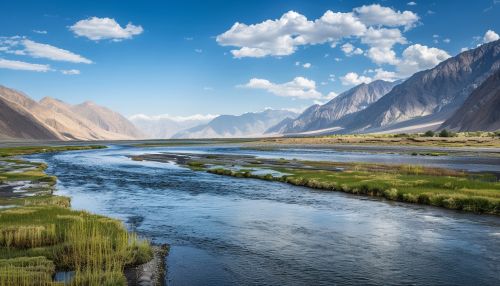Rhone
Geography
The Rhone is one of the major rivers of Europe, originating in Switzerland and running through southeastern France. Its source is the Rhone Glacier in the Swiss Alps, from where it flows into Lake Geneva and then heads south. The river has a length of 813 kilometers (505 miles) and a drainage basin of 98,000 square kilometers (38,000 square miles).


The Rhone is known for its strong current and high water volume, making it one of the most powerful rivers in Europe. It is navigable from Lyon to the Mediterranean Sea, a distance of approximately 300 kilometers (186 miles). The river's course is generally divided into two parts: the Upper Rhone, from its source to Lyon, and the Lower Rhone, from Lyon to the sea. The Upper Rhone is characterized by a narrow, steep valley, while the Lower Rhone flows through a wide, flat plain.
Hydrology
The Rhone has a catchment area that includes a wide variety of landscapes, from the high mountains of the Swiss Alps to the lowlands of the French Mediterranean coast. This diversity results in a complex hydrological regime, with significant variations in water flow and quality.
The river's flow is strongly influenced by the melting of the Alpine glaciers in spring and summer, which leads to high water levels. In contrast, the flow is much lower in winter, when the precipitation falls as snow in the mountains. The Rhone also receives water from numerous tributaries, the largest of which are the Saone, the Isere, and the Durance.
The water quality of the Rhone has been a concern for many years. Industrial and agricultural activities in the catchment area have led to pollution problems, including the presence of heavy metals, pesticides, and other harmful substances. However, efforts have been made to improve the situation, and the river's water quality has improved significantly in recent years.
Ecology
The Rhone River is home to a rich variety of flora and fauna. Its banks and floodplains support diverse ecosystems, including forests, wetlands, and grasslands. The river itself is inhabited by numerous species of fish, including trout, pike, and carp. The Rhone is also an important corridor for migratory birds.
However, the river's ecology has been significantly affected by human activities. The construction of dams and other hydraulic structures has altered the river's flow and habitat. Pollution and overfishing have also had a negative impact on the river's biodiversity. Conservation efforts are currently underway to restore and protect the Rhone's ecosystems.
History
The Rhone has played a significant role in the history of Europe. Its valley has been inhabited since prehistoric times, and it has served as a major transportation route for thousands of years. The river was used by the Romans, who built several cities along its banks, including Lyon and Arles. During the Middle Ages, the Rhone was an important trade route, and many towns and cities grew up along its banks.
In the 19th century, the Rhone became a major source of hydroelectric power. Numerous dams were built along the river, providing electricity for the rapidly industrializing regions of France and Switzerland. Today, the Rhone is still a major source of power, with its dams producing a significant portion of the electricity used in the region.
Economy
The Rhone River plays a crucial role in the economy of the regions it flows through. It provides water for irrigation, supports fishing and aquaculture, and is a major source of hydroelectric power. The river is also used for transportation, with several ports located along its course.
The Rhone Valley is known for its vineyards, which produce some of the finest wines in the world. The region's warm, sunny climate and diverse soils create ideal conditions for viticulture. The Rhone Valley is particularly famous for its red wines, which are made from a variety of grape varieties, including Syrah, Grenache, and Mourvedre.
Tourism is another important sector of the Rhone's economy. The river's beautiful landscapes, historic cities, and cultural heritage attract millions of visitors each year. River cruises are a popular way to explore the Rhone Valley, offering a unique perspective on the region's scenery and attractions.
